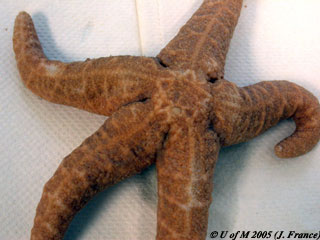
 |
Phylum Echinodermata
(Canadian Campbell 2nd ed Concept 33.5)
Echinoderms are exclusively marine organisms possessing spiny skin.
The phylum displays primary bilateral symmetry with both embryonic and larval
stages being bilaterally
symmetrical. However, when the larvae settle on the sea floor to
develop into adults, the organisms become
radially symmetrical (image).
Echinoderms are usually considered as being related to the chordates. Members of both phyla show the basic characteristics of deuterostomes, with indeterminate and radial cleavage. The position of the blastopore corresponds to the position of the anus in the adult. Both have a true coelom which arises as out-pouchings from embryonic mesoderm and the larvae of each group show certain similarities.
Class Stelleroidea (Asteroidea)
 The
common starfish, Piaster, found along the Atlantic coast of North America
is a typical example of this class. Starfish crawl over the bottom or live in
tide pools among the rocks and sand of the seashore and coral reefs. They are
sometimes serious predators of oyster beds.
The
common starfish, Piaster, found along the Atlantic coast of North America
is a typical example of this class. Starfish crawl over the bottom or live in
tide pools among the rocks and sand of the seashore and coral reefs. They are
sometimes serious predators of oyster beds.
Examine the oral, or ventral surface. Each arm contains grooves extending outward from the centrally located mouth. Running from the floor of the grooves are tube feet. These are highly contractile tubes which terminate in sucker-discs. The combined efforts of the tube feet provide attachment to the substrate and are the means by which locomotion is accomplished.
Note that the body is composed of a central disc from which radiate five arms. The opposite spiny surface is aboral, or dorsal. Locate the madreporite, a small porous button-like structure, at one side of the aboral surface. The anus is situated near the centre of the disc on the aboral surface. The spines of the aboral surface are part of a small calcareous plate that lies buried beneath the integument (body wall). These plates form the exoskeleton. Turn the starfish over and locate the mouth on the oral surface.
Use a pair of scissors to carefully remove the integument starting at the dorsal edge of the cut arm and working your way slowly towards the madreporite. You should completely expose the dorsal surface of the arm and central disc of the starfish.
The exposed body cavity or coelom in the central region is mainly occupied by parts of the digestive system. There is a short esophagus, which leads from the mouth, to the large cardiac portion of the stomach, which consists of 5 pouches, one per arm. The cardiac stomach everts through the mouth at the time of feeding, and after digestive enzymes have acted upon the food, the stomach contents are retracted into the body by means of special retractor muscles, a pair of which extend into each arm. Aborally the cardiac portion of the stomach leads into the smaller, thin-walled and flattened pyloric portion of the stomach. The pyloric stomach receives the common ducts from five pairs of hepatic caeca . A pair of hepatic caeca (digestive glands) extend into each arm. From the middle of the upper portion of the pyloric stomach a short rectum extends to the anus which is located on the aboral surface.
Gonads are conspicuous in specimens captured during or just prior to the reproductive season. They are simple branched, lobulated sacs (one pair per arm) that open to the exterior by ducts which open on the lateral, aboral surfaces close to the junction between arms.
Examine the water vascular system in an arm. The water vascular system consists of a circum-oral vessel (ring canal) which connects to the madreporite via a calcified stone canal and five radial canals which lead into numerous short transverse canals that connect to the tube feet. A radial canal runs the entire length of each arm. An individual tube foot consists of a closed cylinder with a sucker at the distal end and at its proximal end, a bulb-like ampulla lying within the body.
Examine a starfish arm in C.S. showing the tube feet
![]()
